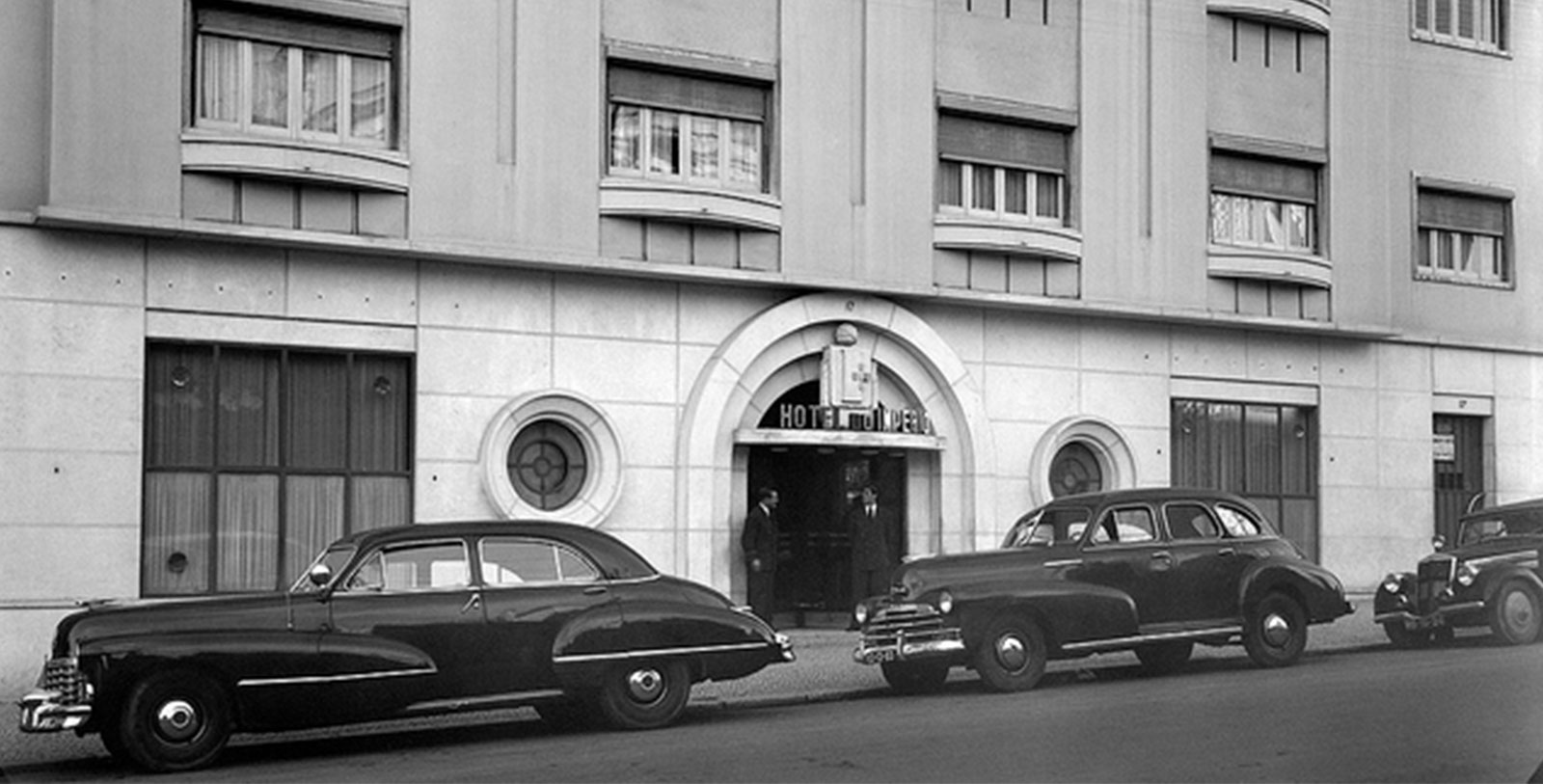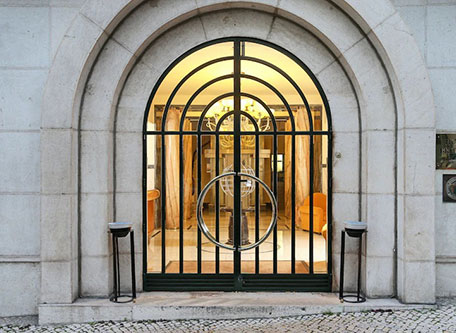Receive for Free - Discover & Explore eNewsletter monthly with advance notice of special offers, packages, and insider savings from 10% - 30% off Best Available Rates at selected hotels.
history
Discover the Hotel Britania Art Deco, which was designed by renowned Portuguese architect Cassiano Branco.
Hotel Britania Art Deco, a member of Historic Hotels Worldwide since 2022, dates back to 1944.
VIEW TIMELINEBy the middle of the 20th century, Lisbon’s Avenida de Liberdade was rapidly becoming one of the most popular places to visit in the city. Born out of a luxurious public park in the late 1800s, the thoroughfare had since seen the creation of countless restaurants and storefronts that appealed to affluent travelers. To accommodate the sheer rise in visitation to the area, entrepreneurial businesspeople began developing numerous boutique hotels along the avenue. Among the many to debut next to the Avenida de Liberdade was the Hotel do Império in 1944. Its owners spared no expense in designing the structure either, enlisting the help of renowned Portuguese architect Cassiano Branco. An accomplished user of modernist themes, Branco proceeded to craft the hotel’s stunning appearance with the latest Art Deco motifs. When the construction on the building finally concluded several months later, it stood as one of the most outstanding holiday destinations in Lisbon. Indeed, many influential guests visited not long thereafter, including Tomaz Ribas, Francisco de Sousa Tavares, and the business magnate Antenor Patiño. But great intellectuals also graced the halls of the Hotel do Império, such as Assis Pacheco, Sophia de Mello Breyner, José Cardoso Pires, and Armando Baptista-Bastos. In fact, writer Natália Correia herself had married the hotel manager and lived with him on the fifth floor in what is now Room 52. The apartment quickly developed a reputation for its grand dinner parties, as well as the late-night literary discussions that Correia held frequently. According to a story told by filmmaker Dórdio Leal Guimarães, Natália Correia even shut herself up in the hotel to write the play O Encoberto.
Great European entertainers stayed at the Hotel do Império as well, like Omar Sharif and Raul Solnado. Spanish actress Carmen Sevilla specifically spent a few days inside the building while promoting her film, Violetas Imperiales. The local press reported that Sevilla gave interviews at the Hotel do Império before finally going to the premiere at the nearby Odeón movie theater. Vinícius de Moraes also booked a guestroom when he came to perform some shows at the Teatro Villaret during the late 1960s. The poet Alexandre O'Neill recounted that at dawn on February 28, 1969, Moraes was returning to the Hotel do Império when an earthquake struck the city. He then wrote the sonnet “Lisboa tem terremoto…” on-site, which praised Lisbon’s tenacity. The literary piece praised several figures he met in Lisbon, too, specifically Chico Buarque, Nicolau Breyner (whom he met at the bar of the Hotel do Império), and O’Neill himself. Now known as the “Hotel Britania Art Deco,” this spectacular historic hotel continues to be one of the best places to stay within the heart of the city. It is also among the last historic hotels left standing on the Avenida de Liberdade, thanks to the stewardship of Lisbon Heritage Hotels. Lisbon Heritage Hotels instituted a comprehensive renovation of the entire structure during the early 2000s as part of its greater goal of preserving the rich heritage of Lisbon and Portugal. Cultural heritage travelers are certain to appreciate the care that Lisbon Heritage Hotels have undertaken to protect the Hotel Britania Art Deco, in addition to the upscale services that they have instilled throughout. Hotel Britania Art Deco has been a member of Historic Hotels Worldwide since 2022.
-
About the Location +
While Lisbon today is among the most historic metropolises in Europe, its origins are a bit of a mystery. Historical evidence is scant regarding its founding, although recent archeological findings suggest the region was inhabited as far back as the Iron Age. Additional excavations in the heart of Lisbon have uncovered more artifacts that indicate a Phoenician presence dating back to the 12th century B.C. Those objects have enabled scholars to determine that Lisbon most likely formed as a Phoenician trading post that existed under the name “Olisipo.” Even though no record specifically cites the reasoning behind the title, some think that it was an homage to the legendary Greek hero Odysseus. Nevertheless, historians further believe that the village gradually grew into a massive city called “Felicitas Julia” following the Roman conquest of the Iberian Peninsula. The community served as the main bastion of power for the Roman Empire in the area, who developed imposing fortifications along the local waterway, the Tagus River. Those battlements specifically safeguarded the deep-water port at the river’s mouth, which had begun to flourish under Roman rule. But when the Roman Empire collapsed during the 5th century A.D., the settlement passed through various hands before finally getting captured by the Visigoths. They, in turn, lost control of the city to the Moors several centuries later. The Moors subsequently reinforced the city’s defenses, transforming the locale into an imposing bastion against European knights who wished to take it back. Their work reinforcing Lisbon was masterful, as the fortifications were able to blunt numerous attacks for decades.
In 1147, the Moorish defenses were put to the ultimate test when the Portuguese king Afonso I attempted to seize the city amid the Second Crusade (and the greater Portuguese Reconquista). At the head of a massive army, Afonso I managed to wrestle control from the Moors following a dramatic four-month-long siege. Now known as “Lisbon,” the city quickly emerged as an important commercial center in the nascent Kingdom of Portugal. Despite its rising economic status, the Portuguese Royal Family held its official court several hundred miles away in Coimbra. But King Afonso III decided to relocate the royal residence to Lisbon in the mid-13th century, thus making it the capital for the entire kingdom. Lisbon thrived due to its newfound political significance, with successive generations of Portuguese monarchs investing heavily into its continued development. Some of the most notable projects involved King Dinis I’s creation of the Studium Generale and the massive renovations that King Fernando I did to the ancient Castelo de São Jorge. Perhaps the greatest work to transpire occurred during the reign of King Manuel I, who oversaw the widespread urbanization of Lisbon. Among the best structures that he commissioned at the time included the Torre de Belém (Belém Tower) and the Paço da Ribeira (Ribeira Palace). Manuel had obtained much of the wealth to finance the construction via the great riches that had begun to flow into Lisbon’s harbor from Portugal’s newly created distant colonies. The amount of trade conducted became so great that Lisbon eventually established itself as one of Europe’s greatest cities by the end of the 16th century.
This renaissance came to an unfortunate end when a massive earthquake caused catastrophic damage throughout the city in 1755. Undeterred, the local residents banded together to rebuild most of Lisbon in a matter of years. Spearheading the revitalization efforts was Sebastião José de Carvalho, Portugal’s prime minister. He worked closely with a team of architects to redesign much of Lisbon’s historic districts, creating many new buildings in a simple, yet gorgeous style of Baroque architecture that became known as “Pombalino.” (The moniker was an homage to Carvalho, whose royal title was the Marques de Pombal.) Lisbon resumed its place as a prominent European community for many years, even as war, political instability, and economic depression periodically impacted Portugal in the 19th and 20th centuries. In fact, the city only continued to grow, as epitomized by the creation of a magnificent new thoroughfare that bisected the heart of Lisbon called the “Avenida de Liberdade.” (The boulevard specifically debuted at the height of Europe’s Belle Epoque period in the 1890s.) Following the country’s integration into the European Union at the start of the 21st century, Lisbon has solidified its standing as an elite, internationally renowned metropolis. Its rich character has inspired thousands of contemporary travelers to visit every year, placing it on par with other popular destinations throughout the Mediterranean Basin like Venice and Rome. Indeed, Lisbon’s many fascinating historic sites—including the Torre de Belém, the Paço da Ribeira, and the Castelo de São Jorge—have been essential for maintaining this incredible international interest. Most of those historical sites have also contributed to the creation of Lisbon’s spectacular UNESCO World Heritage Site, which encompasses large tracts of its downtown core.
-
About the Architecture +
When Cassiano Branco first designed this fantastic historic hotel, he used Art Deco architecture as the source of his inspiration. Art Deco architecture is among the world's most famous architectural styles. The form initially emerged from a desire from architects to break with past precedents to find architectural inspiration from historical examples. Instead, professionals within the field aspired to forge their own design principles. More importantly, they hoped that their ideas would better reflect the technological advances of the modern age. Historians today often consider Art Deco to be a part of the much wider proliferation of cultural “Modernism” that first appeared at the dawn of the 20th century. Art Deco as a style first became popular in 1922, when Finnish architect Eliel Saarinen submitted the first blueprints to feature the form for the contest to develop the headquarters of the Chicago Tribune. While his concepts did not win over the judges, they were widely publicized. Architects in both North America and Europe soon raced to copy his format in their own unique ways, giving birth to modern Art Deco architecture. The international embrace of Art Deco had risen so quickly that it was the central theme of the renowned Exposition des Art Decoratifs in Paris a few years later. Architects worldwide fell in love with Art Deco’s sleek, linear appearance defined by a series of sharp setbacks. They also adored its geometric decorations that featured motifs such as chevrons and zigzags. But despite the deep admiration people felt toward Art Deco, interest in the style gradually dissipated throughout the mid-20th century. Many examples of Art Deco architecture survive today, with some of the best located in places like New York City, London, Paris, and of course, Lisbon.
-
Famous Historic Guests +
Omar Sharif, actor known for his roles in such films like Lawrence of Arabia, Funny Girl, and Doctor Zhivago.
Carmen Sevilla, actress known for her roles in such films like Violetas Imperiales, Don Juan, and Buscando a Mónica.
Nicolau Breyner, well known actor throughout Portugal who appeared in more than 170 films and television shows.
Raul Solnado, actor known for his work in América, The Millionaire, and O Tarzan do 5o Esquerdo.
Assis Pacheco, actor and composer known for his work in Ill-Fated Love, Cabocla Bonita, and Madragoa.
Vinícius de Moraes, poet, writer, and lyricist remembered today as “O Poetinha,” or “The Little Poet.”
Tomaz Ribas, professor and writer who was a revered critic of performing arts throughout Portugal.
Francisco de Sousa Tavares, civil rights activist who spent much of his life campaigning against the Salazar dictatorship.
Antenor Patiño, Bolivian business tycoon known as the “King of Tin.”
Armando Baptista-Bastos, writer known for such novels like Bicicletas em Setembro.
Natália Correia, poet and social activist known for many literary works, including O Encoberto.
José Cardoso Pires, author known for writing many literary works, such as the novel O Delfim.
Sophia de Mello Breyner, poet known for such literary works like A Menina do Mar, A Fada Oriana, and O Cavaleiro da Dinamarca.


























